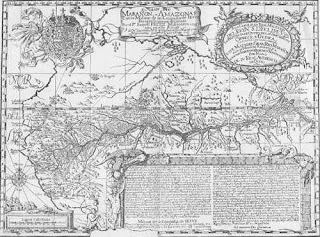Samuel Fritz (1654 – 20 March 1728) was a Czech Jesuit missionary who made the first map of the Amazon in 1707.
 |
| Fritz Map |
Engraver Juan de Narvaez printed a more elaborate version of the map.
Fritz' job, which he had no training for, was to map the upper Amazon so Catholic religious factions could determine who controlled which areas.
Fritz began (1687) the cartographical delineation of the disputed missionary territory on the Upper Marañon between Peru and Quito. In 1689 he undertook, in a pirogue, an expedition down the Amazon to Pará.
Poorly equipped with instruments, he completed a comparatively accurate chart of the river's course. This was the first approximately correct chart of the Marañon territory. He was also the first to follow the Tunguragua instead of the Gran Pará (Ucayali) and prove it the real source of the Marañon.
Wikpedia, "Samuel Fritz."
Fritz didn't exactly put Iquitos on the map, but he did make the map Iquitos would be put on.
Fritz had something that I have, a moral compass. Mine is sometimes not so accurate and not so reliable. Every traveller has a moral compass, and some even have a map to guide them from where they are to where they hope to go. Some, of course, wish to go to dangerous places. Some go blindly at random and find experience along the way, no working compass, no map, no guide. Paths are often crooked, and one wanders far from the straight and narrow. There is outright perdition. Iquitos, Peru. We are here, and we are together in this place and time, though each alone and on a way to somewhere we know not exactly of. Fritz had that map long before he first stepped into the Amazon. For most of us today that map doesn't exist till we make it ourselves. What follows is, roughly, my map of Iquitos, Peru.
I was thinking of an old movie recently, a movie by a traveller with strange and terrifying mind maps swarming with beasts and monsters. It brought to mind a song I like. One might wonder where we are all going, though we are all in Iquitos in one way or another, many of us on alien jungle paths. I like to hum along as I wander. Quo vadis? No idea. I don't have the benefits of Samuel Fritz' map.
http://www.dailymotion.com/
A gentle reminder that my book, An Occasional Walker, is available at the link here:
http://www.amazon.com/Occasional-Walker-D-W/dp/0987761501/ref=sr_1_1?s=books&ie=UTF8&qid=1331063095&sr=1-1
And here are some reviews and comments on said book:
http://nodhimmitude.blogspot.com/2012/04/dagness-at-noon.html




No comments:
Post a Comment